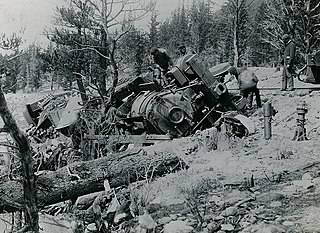
A railroad car, railcar, railway wagon, railway carriage, railway truck, railwagon, railcarriage or railtruck, also called a train car, train wagon, train carriage or train truck, is a vehicle used for the carrying of cargo or passengers on a rail transport network. Such cars, when coupled together and hauled by one or more locomotives, form a train. Alternatively, some passenger cars are self-propelled in which case they may be either single railcars or make up multiple units.

Pakistan Railways is the state-owned railway operator in Pakistan. Founded in 1861 as the North Western State Railway and headquartered in Lahore, it owns 7,789 kilometres of operational track across Pakistan, stretching from Peshawar to Karachi, offering both freight and passenger services, covering 482 operational stations across Pakistan.

In rail transport, a derailment is a type of train wreck that occurs when a rail vehicle such as a train comes off its rails. Although many derailments are minor, all result in temporary disruption of the proper operation of the railway system and they are a potentially serious hazard.

The British Rail Class 222 Meridian is a group of 5- or 7- car diesel-electric multiple-unit high-speed passenger train capable of 125 mph (200 km/h). Twenty-seven sets were built by Bombardier Transportation in Bruges, Belgium.

The Charfield railway disaster was a fatal train crash which occurred on 13 October 1928 in the village of Charfield in the English county of Gloucestershire. The London, Midland and Scottish Railway (LMS) Leeds to Bristol night mail train failed to stop at the signals protecting the down refuge siding at Charfield railway station. The weather was misty, but there was not a sufficiently thick fog for the signalman at Charfield to employ fog signalmen. A freight train was in the process of being shunted from the down main line to the siding, and another train of empty goods wagons was passing through the station from the Bristol (up) direction.

Over the latter years of the 19th and early years of the 20th centuries, Penistone in Yorkshire gained a name as an accident black-spot on Britain's railway network; indeed, it could be said to hold the title of the worst accident black-spot in the country. The main line through the town was the Woodhead route of the Manchester, Sheffield and Lincolnshire Railway between Sheffield Victoria and Manchester, London Road. The line was heavily graded with a summit some 400 yards inside the eastern portal of the Woodhead tunnel.

The Thirsk rail crash occurred on 31 July 1967 at Thirsk, Yorkshire, England on the British Rail East Coast Main Line.
There have been a number of train accidents on the railway network of Victoria, Australia. Some of these are listed below.
The railways of New South Wales, Australia have had many incidents and accidents since their formation in 1831. There are close to 1000 names associated with rail-related deaths in NSW on the walls of the Australian Railway Monument in Werris Creek. Those killed were all employees of various NSW railways. The details below include deaths of employees and the general public.
A derailment of a night mail train from Scotland to London occurred on the North Eastern Railway when a tender axle suddenly fractured on 28 December 1869 near Dalton Junction, south of Darlington, England. There were only slight injuries among the staff, but the accident was a warning of the problem of premature axle failure.
There have been a number of train accidents on the South Australian railway network. The first known incident in this list occurred in 1873 in Smithfield.
This is a list of significant railway accidents in Queensland, Australia.

The 1936 Paraparaumu train wreck occurred on Sunday, 30 August 1936 near Paraparaumu, New Zealand. A train was travelling from Auckland to Wellington in heavy rain when it derailed after striking a landslide across the tracks. One passenger died as a result of injuries received in the incident.

The 1887 Hartford Railroad Disaster, also known as the West Hartford Bridge Disaster, occurred on February 5, 1887, near Hartford, Vermont. It remains the deadliest train accident in Vermont's history, resulting in the deaths of approximately 37 individuals and injuring around 50 others.








